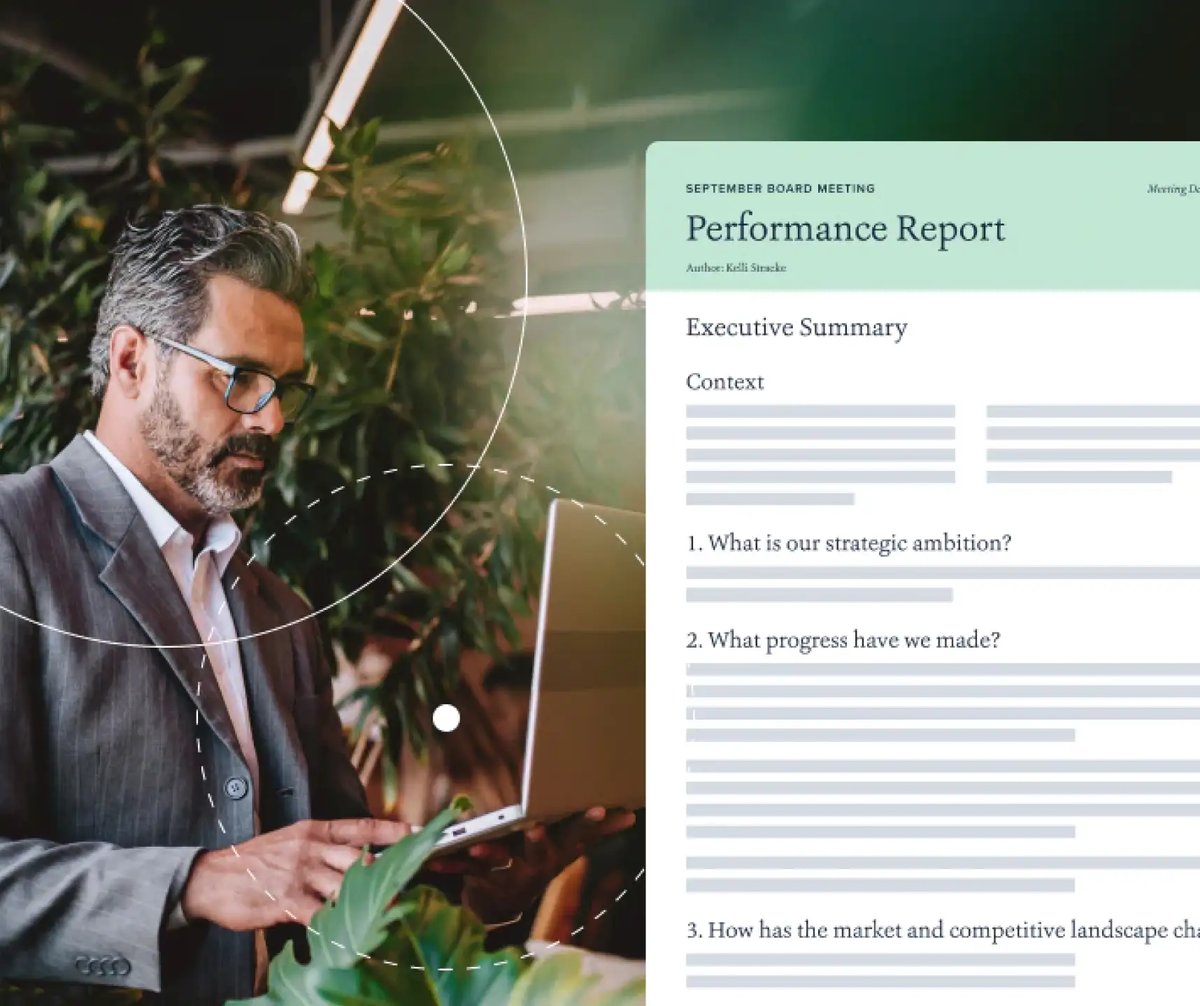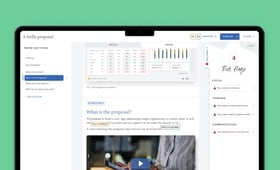
Board and management papers
Reporting slows most organisations down. It doesn’t have to.
Board packs shouldn’t slow your organisation down. But with the average pack now over 200 pages long and two-thirds of directors rating their board materials as “Weak” or “Poor”, that’s exactly what’s happening. Here’s our take on what’s going wrong and how to fix it.
What are board and management papers and why do they matter?
Board and management papers are the written reports that inform decision-making at board and executive level. Together, these papers make up your board pack — the collection of documents directors receive before each board meeting.
When they’re done well, board and management papers are conversation catalysts. They surface the insights directors need to challenge management constructively, spot risks and opportunities early, and make confident decisions. They make efficient use of directors’ preparation and meeting time by helping directors focus on the organisation’s priorities and add value where it’s needed.
When they’re done poorly, they have the opposite effect. They obscure insight beneath mountains of data, bury bad news, and leave directors guessing what management actually thinks — and whether they’re the right people to run the business. The result? Unproductive board meetings, delayed decisions, and boards that can’t deliver the oversight and foresight their organisations need.
What are the common challenges with board and management reporting ?
Our research with the Chartered Governance Institute UK & Ireland has tracked the state of board reporting since 2018. Over 1,000 organisations have used our board pack assessment tool to benchmark their materials, and the findings paint a troubling picture.
The average board pack has grown, with 24% of board packs over 200 pages long in 2025 compared with 13% in 2020. Our research suggests that half of this goes unread; directors can read around 30 pages an hour, and they spend around four hours reading their packs on average.
And it’s not just that packs are too long — 68% of directors and governance professionals now rate their board materials as “Weak” or “Poor” and only 36% of directors think their board packs add any value.
The problems can be categorised as follows:
- Lack of focus. Papers aren’t aligned with the board or organisation’s big picture priorities. 56% of directors tell us that the information they receive is too internally focused and 66% say their board papers don’t accurately reflect their organisation’s priorities.
- Poor communication. Key messages are buried deep, and the information is hard to digest. More than half (57%) of board members say finding the key messages in their papers is like finding a needle in a haystack. Executive summaries — when they exist at all — often set the scene rather than distilling the insight. And too many writers hide behind passive and overly formal language rather than writing simply and owning their message, making long reports hard to engage with.
- Lack of critical thinking. Papers share information without applying judgment and create risky blind spots. Nearly half of directors (42%) think their management reports aren’t upfront about bad news. Writers fail to tackle the difficult questions or consider the implications of the information being presented. The result is reports that chronicle activity rather than surface the insight directors need to make decisions.
This is more than a source of frustration for board members. Poor board packs make boards slow to spot risks, make decisions, and make changes, but it’s often also symptomatic of deeper problems in the organisation: muddled thinking, misalignment, and patchy communication.
What’s more, writing board reports consumes significant time and attention. Whether that’s management time spent drafting and redrafting reports, or governance team time spent chasing papers and editing them, the impact on the organisation’s productivity is marked. And, when board packs don’t deliver what’s needed, it’s time that could arguably be better spent.
What reports should a board pack include?
Not all board papers are created equal. Here are the most important types and how to get them right.
The CEO’s report
Directors tell us the CEO’s report is the most important paper in the board pack and the one they turn to first. It’s where the CEO answers the question “What’s on my mind?” and guides the board’s attention to where it’s needed most.
A great CEO’s report provides context for the rest of the pack, flags what’s going well and what isn’t, and makes a direct ask of the board. It balances backwards-looking reflection with forward-looking outlook. And it’s written in the CEO’s voice — candid, personal, and clear about where the board’s counsel would be most valuable.
KPI dashboards
KPI dashboards should provide a holistic snapshot of your organisation’s health and outlook on a single page. They answer four powerful questions: Are we on track? Where do we need to improve? Where are our opportunities? What’s changed?
The best dashboards align KPIs with your big-picture goals and strategy, display insights and trends at a glance, and focus on the metrics that drive value creation.
Decision papers
Decision papers can make or break your board’s most critical choices. They need to demonstrate that you’ve followed a logical process, outline the business case clearly, and be candid about risks and mitigations.
The best decision papers show that you’ve considered all relevant options (including the option to do nothing), explain why you’re recommending a particular course of action, and spell out the impact on all stakeholder groups. They provide enough detail for directors to feel confident in their decision without overwhelming them with operational minutiae.
Management reports
Management reports give the board a clear view of how a business unit, function, or team is performing. They’re a chance to instil confidence and build trust by demonstrating that you understand what’s driving performance and can be trusted with resources and decisions.
A strong management report connects past performance to the outlook. It’s structured around four questions: What are we trying to achieve? How are we performing against plan? What’s our outlook? What are the implications and what do we need from the board?
How do you know what good looks like?
Our guides outline best practices for core board and management papers and share tips and templates to help management deliver it.
What solutions can help improve board and management paper quality ?
Improving board reporting requires both the right methodology and the right tools. At Board Intelligence, we’ve spent 20 years helping organisations transform their board and management papers with board reporting software and expert advisory services built on a proven methodology: the QDI Principle™.
Board reporting software
Report Writer, our AI-powered report writing tool, helps management create high-quality papers in record speed.
Report Writer starts by analysing your materials — whether that’s data files, recent reports, or notes you’ve jotted down — and creates a first draft in seconds. But it doesn’t stop there. As you refine your paper, Report Writer provides expert guidance based on 20 years of boardroom insights: it highlights what’s working, what’s missing, and what you can do about it.
The tool is built around the QDI Principle™, our methodology for high-quality thinking and writing. It prompts authors to:
- Link their report to the organisation’s big picture and strategy.
- Answer the difficult questions directors need answered.
- Surface actionable insight, not just information.
- Own the message using first-person, active language.
- Write concisely and cut unnecessary detail.
Because Report Writer is available directly within Microsoft Word, Excel, and SharePoint, there’s no new process to learn. Your team can enhance their papers with graphs, tables, and slides without leaving the tools they already use.
And because it’s built and administered by us, your data remains your data. It will never be shared, saved by the AI, or used for training.
Board reporting advisory services
Sometimes, you need more than software. Our team of board reporting experts provide hands-on support to transform your board reporting and embed lasting change that supercharges board performance.
Board pack diagnostics
In a deep-dive board pack review, we’ll assess the strengths and weaknesses of your board materials, benchmark your pack against your peers, and identify the specific actions you can take to deliver transformational improvement. You can get started with our free assessment tool.
Bespoke board pack redesign
We’ll work with you to redesign your entire board pack — from the structure and format to the questions your papers answer. This includes creating custom KPI dashboards that align with your strategy and tell your value creation story on a single page. This can be particularly impactful for organisations going through strategic transformations, significant M&A, or a change of leadership.
Report writing training
Great writers aren’t born; they’re made. Our interactive training workshops equip your team with the skills to deliver actionable insight every time. We’ll teach them how to structure their thinking, communicate with impact, and write papers that hit the mark. We can also share best practices for data visualisation so that data becomes an effective part of the story.
Agenda planning & alignment
A strategic, manageable agenda is key to a strategic, digestible board pack. We can focus valuable board time on the topics and decisions that matter most by developing forward-looking board calendars and meeting agendas that align with your board’s priorities.
How can AI report generation save time while improving the quality of board papers?
AI tools make it easier than ever to produce more content, which is partly why board packs keep getting longer. But used properly, AI can help you write less, not more — and deliver better insight in the process.
The key is understanding what AI does well and what it doesn’t. Generic AI tools like ChatGPT are poor writers but fantastic editors. They can condense content, but they can’t extract meaningful insight or spot what’s missing. That’s why Report Writer is different.
Report Writer is built specifically for board and management reporting. It summarises your information while also challenging you to think more deeply about it. It asks: Have you linked this to your organisation’s strategy? Have you considered all the options? Are you being candid about the risks? What’s your ask of the board?
This approach delivers significant time savings. Writers get a first draft in seconds rather than staring at a blank page for hours. Real-time guidance helps them spot gaps and fix issues as they write rather than after multiple review cycles. And because Report Writer encourages clearer thinking and tighter writing, the papers that reach the board are shorter, sharper, and more focused.
The result isn’t just faster report writing. It’s better thinking, faster decisions, and more productive board conversations.
Read our guides to AI for the board pack and AI for board meeting preparation to learn more.
How do I get started improving board and management papers?
Great board and management papers don’t happen by accident. They’re the result of clear thinking, effective communication, and a relentless focus on what matters. With the right approach and the right tools, you can turn your board pack from a burden into a driver of organisational performance.
Improving your board reporting starts with understanding where you are today. Use our free board reporting self-assessment tool to identify the strengths and weaknesses of your current materials and get personalised advice on how to improve.
And, if you’re ready to transform your reporting, get in touch to speak to our team of board reporting experts or see Report Writer in action.
FAQs
-
What’s the difference between board reporting software and board management software?
Board reporting software focuses on creating high-quality content — helping management write clearer, more insightful papers. Board management software handles distribution and governance: agendas, materials, annotations, and compliance. In short, reporting software improves what goes into your board pack, while management software ensures it reaches the right people securely.
-
What’s the ideal length of a board pack?
This will vary by organisation. Rather than aiming for a specific page count, focus on ruthless prioritisation: does every paper answer questions the board needs to consider, and does the information within each paper move directors’ understanding of the topic forward?
-
Can AI improve the quality of board papers?
It depends how you use it. Generic AI tools make it easier to produce more content, which is one reason board packs are getting longer. But AI built specifically for board reporting — like Report Writer — challenges writers to think more deeply, highlights gaps, and guides them to write more concisely. The result is papers that are shorter, sharper, and more focused on insight.
-
How do I get management to write better board papers without micromanaging them?
The most effective approach combines clear methodology (like the QDI Principle), smart templates that prompt the right thinking, and technology that provides real-time guidance. When you embed these across your organisation, writers get the support they need without constant oversight.
-
What’s the biggest mistake organisations make when trying to improve their board reporting?
They focus on templates and formatting rather than skills and behaviours. A template can help, but it can’t make people think more critically or write better. Improvements come from teaching your team what good looks like and then giving them the tools to put it into practice. The biggest leaps happen when management see the value they get back from a high-quality paper — faster decisions, deeper board engagement, more focused support.
With Report Writer, you can go from blank page to ready-to-share paper in a blink, with the help of AI built on 20 years of report writing expertise.
See report writer

